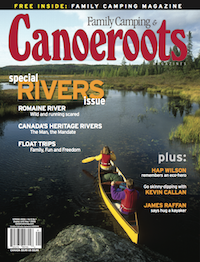At the Kendal Mountain Film Festival, held in England each fall for the last 25 years, there used to be one night in a week of climbing films dedicated to paddling and muddy bikes. Such has been the growth of interest in these two topics over the years, however, that last fall organizers decided to separate the boats and the bikes and offer whole evenings of each.
I’m not sure how the muddy bike evening sold, but the paddling program played to a packed house. It included presentations by two conventional open canoeists; Paul Grogan told of his odyssey down the Amur River along the Mongolian-Siberian border and yours truly talked about “Bugs, Blogs and Broken Canoes” in Canada. These live offerings were intermixed with a bevy of the latest whitewater paddling films.
Paul Grogan’s story was both funny (ridiculous hassles with the Chinese and Russian bureaucracies) and heart warming (generous people along the way took them in without hesitation) and sent the audience running to buy his book, Barbed Wire and Babushkas. My Canadian canoeing stories went over fine too. But the real story was the whitewater films, which ranged from beautiful to totally obscene.
A five-minute short called Falling was a masterwork of light play and creative camera pans on a kayaker shooting and re-shooting a medium-sized falls. No one was injured in the film and, as far as I know, there were no puddles under anyone’s seat when the credits rolled. The other films however, amounted to an orgy of total insanity.
TWO APPROACHES TO FALLING WATER
These films were little more than segments of footage strung together without narrative glue. They bombarded the audience with scene after scene of colourful kayaks falling over cliffs and crashing down waterfalls of increasing height and complexity, all to the nasty incantations of in-your-face neo-punk
music. Boof, bang, splash. Bang, bash and bang again—the act repeated ad infinitum, with the group divvying up the gear of any rag dolls and continuing on downstream after leaving their fallen on shore (not really … they actually airlifted out the guy with the broken back). How these people survive is beyond me, but I’m glad they do.
Since then, I’ve been thinking about the two approaches to falling water. On the one hand, you have the traditional canoeist who would paddle to the ends of the earth to experience a sight like the Nahanni River’s numinous Virginia Falls, just to sit there and reflect on its beauty before heading home. And on the other, you have the whitewater kayakers who would go to such places just to see if there was anything worth “hucking” themselves off.
On the basis of an unofficial poll, and in spite of what’s projected in some of their films, there is another difference between these two groups—and it’s not what you’d think. It’s the hucksters, not the silently reverential ones, you’re more likely to find at rallies and as members of groups trying to preserve these wild places. They’re the politically active ones, or so it seems.
Waterfalls transform the potential energy of calm water into plummeting kinetic energy, stasis into motion, complacency into action. I think some of the wild-hearted souls who get pum- meled by waterfalls have a better appreciation of their transformative essence than those who sit in quiet reflection and then float passively home. Sitting at home, full of appreciation—and potential—is not good enough.
The future of our rivers is being negotiated right now. There’s no bet- ter time to find out about groups like CPAWS and the Canadian Heritage Rivers System. With more participation these groups might become as powerful as American Whitewater is in the United States. AW marshals its 6,700 members in defence of 80 to 100 rivers at any one time. They do the grunt work of forcing their way into decision-making processes to give rivers a voice.
And regardless of what you think of their films, the next time you have the chance (at a conservation rally for a nearby river perhaps), buy a huckster a beer because a) they’re likely flat broke; b) they probably have something interesting to say; and c) it may be the last time you see them.
James Raffan monitors www.cpaws.org and www.chrs.ca to stay informed and active as a paddling conservationist.




